#app review
Text
Possible OSDDID accessible app review?
Antar Chat!
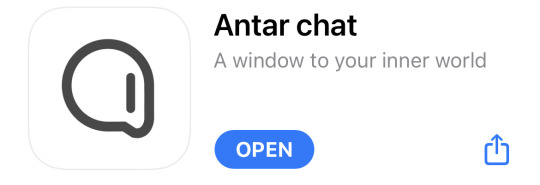
I have only used it for a day, but I’ve found it to be very helpful in getting through the day
Facts:
What type of app it is: an app for having a chat with parts of yourself, as if on an instant messenger
Compatibility: iphone, ipad, mac, ipod touch, iOS 13.0 or later
Size: 20.3 MB
Internet required: none, works just as well offline
Does it share my data?: no
Lockable: yes, by facial recognition. This can be switched off
Light and dark mode are compatible with the phone’s settings itself, rather than the actual app settings
~
Personal thoughts:
Personal difficulty using(0 being the most easy, 10 being impossible): 1-2
How easy to add your parts: 2 (it can be buggy with the choosing colors)
How easy to switch between parts: 0-1
Personal avoidance level: 2-3(its so easy to use, its confronting af to see parts just talking like that >>;)
Some examples of how I’ve used it so far:
I’ve sorted out different sessions to be used as groupings for parts to safely talk. ‘The Cottage’ is the main chat for all parts to engage in. The ‘playroom’ is for little ones + supporting protector parts. Bunnies and Flowers are for sunsystems, ect.
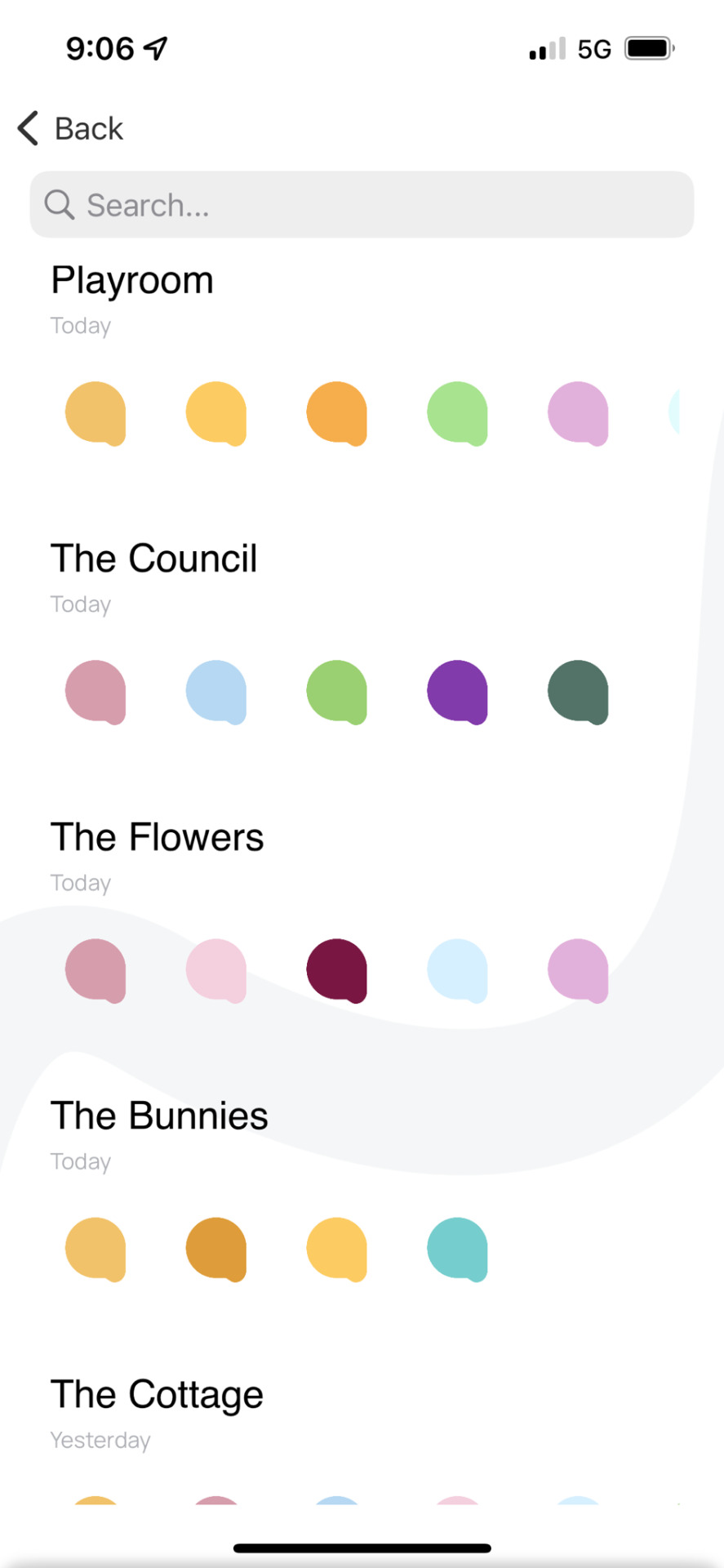
A chat example from today:
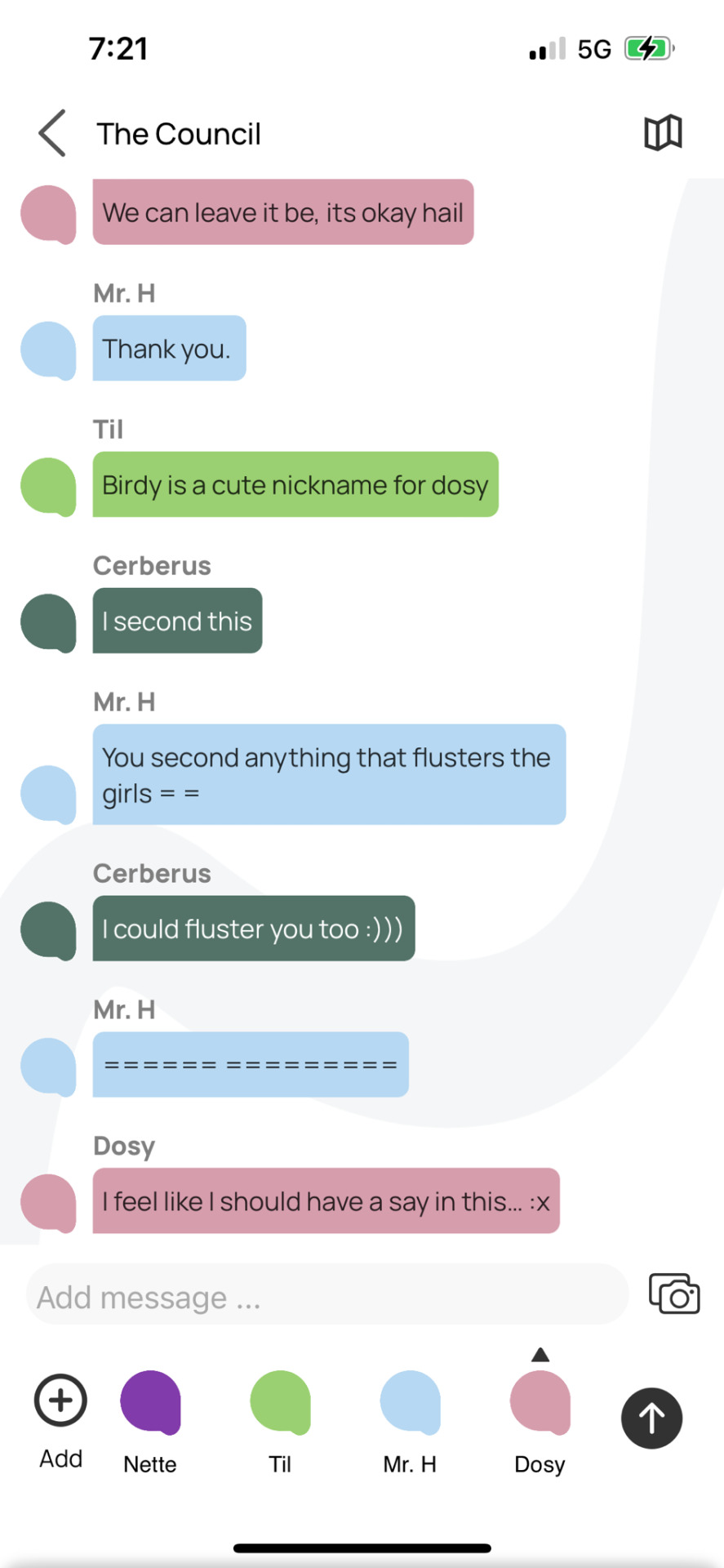
As you can see, the different colors on the bottom can be easily named and switched between. Its as easy as choosing a color for the text to be posted as, really.
Initial thoughts: its so easy and shameless to use. The app was clearly made for IFS in mind, and as such comes pre-loaded with a bunch of emotions as personas. (Like talking directly to your shame, hatred, love, ect ect)
Its extremely basic so I consider it versatile, especially for people who might have less defined parts or maybe find it confronting to even address their parts by name.
Theres none of the complicated fuss you get with discord bots(if you have to type and program something in, i consider it inaccessible to me). Theres no data sharing or complicated interface like Simply Plural(i hate that app). Antar is literally like, what color you like right now? Thats your chat bubble now
Pros:
-extremely simple
-non-confronting because anyone with parts of self can use it, dissociated or not.
-you can have several chatrooms
-the interface is simple and non-distracting or hard to find your way around
-doesnt need internet!
- theres a cute little vent room!! The bg is animated and it really looks like your words are swept away in the wind. Looks like this:
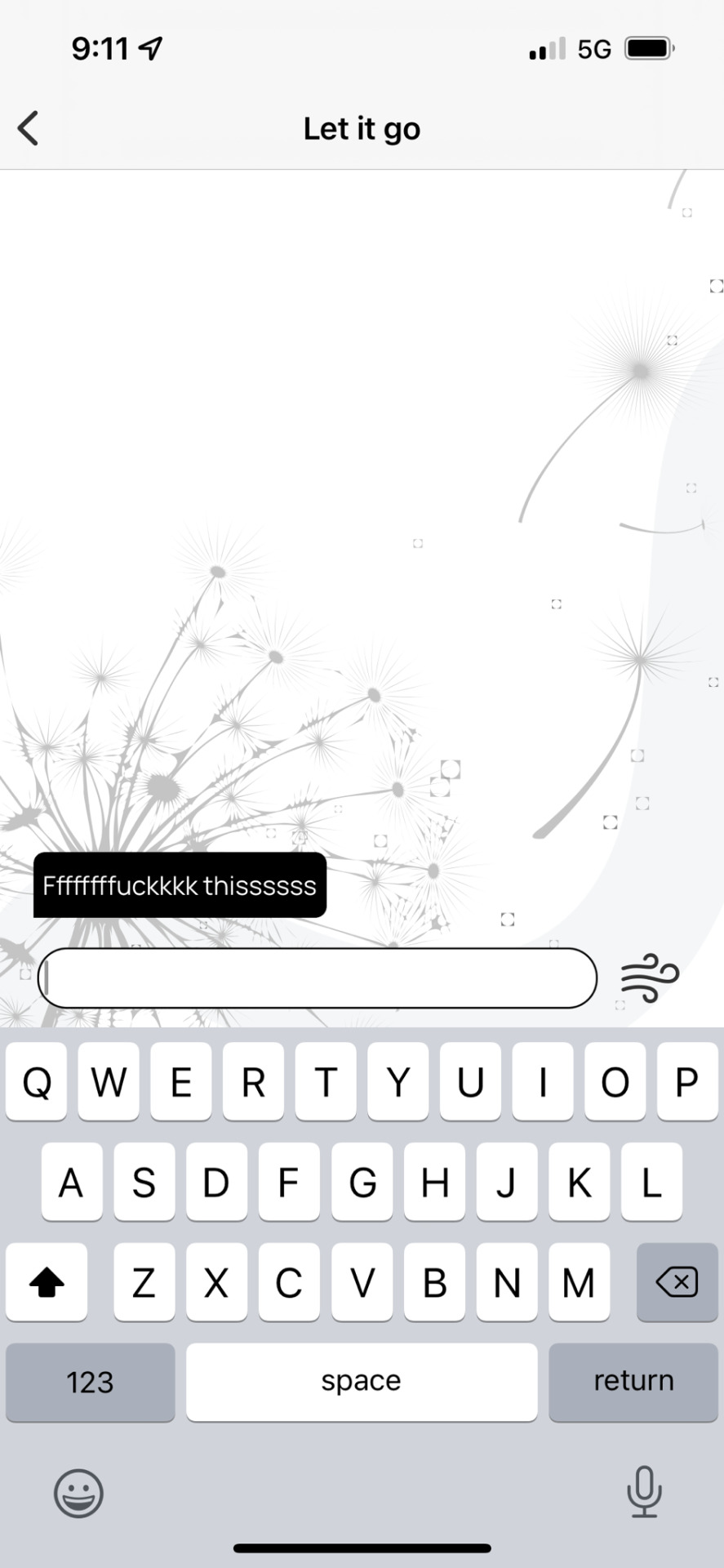
Cons:
- The creator seems to list more features than it has? Or lists them on a way that it looks that way
- Setting ‘personas’ can be a little finicky. I had the worst time trying to get the right colors to set = =; I haven’t tried using images
- theres not really any in-app settings to change
-it can be very easy to accidentally delete sessions/chat rooms so be careful!
-i havent found a way to delete the default personas(all the emotions and whatnot)
-just generally a bit buggy? I hope the person works on it more.
~
Would I recommend this app to someone with OSDDID? Yes! Super easy if you’re looking for a digital way to have internal meetings and discussions. You could probably easily show it to a therapist too, now that I think about it.
#did apps#dissociative identity disorder#otherwise specified dissociative disorder#antar app#app review#app recommendation#bunnidid reviews#sorry if this review isnt my most polished#im tired and typing on phone out of ease#but i wanted to go loooookkkk im trying this out tooooo and its good actually!!!#i absolutely checked it out bc dissociadid recc’d it and got curious#fucking anything but pluralkit or simply plural
481 notes
·
View notes
Text
Human Japanese Lite · app review
(。•̀ᴗ-)✧ review

For those looking to embark on the path of mastering Japanese, Human Japanese Lite offers a solid starting point. This review delves into the pros and cons of the app, highlighting its structured approach, but also addressing its limitations.
Pros:
Structured Learning: Human Japanese Lite impresses with its well-structured approach to teaching the Japanese language. The app divides its content into chapters that alternate between grammar, vocabulary and useful informations. This structured approach ensures a balanced understanding of the language and helps learners progress systematically.
Thorough Explanations: One of the standout features of this app is its thorough explanations of Japanese grammar and vocabulary. Each subject is carefully explained, making it accessible to learners at various levels, from beginners to intermediate students. You'll find detailed insights into the intricacies of the Japanese language.
Comprehensive Basis: Human Japanese Lite provides a comprehensive foundation for learning Japanese. It's an excellent choice for those starting their Japanese language journey, as it covers fundamental concepts thoroughly. The clear explanations help build a strong linguistic base.
Textbook-Like Experience: The app offers a textbook-like learning experience on your mobile device. It's as if you have a Japanese language textbook at your fingertips. The content is well-organized, making it easy to navigate and find specific topics.
Chapter-End Tests: Human Japanese Lite enhances the learning process with tests at the end of each chapter. These tests allow learners to assess their understanding and retention of the material, reinforcing what they've learned. This interactive approach keeps learners engaged and accountable.
Cons:
Limited Free Version: While Human Japanese Lite is an excellent resource, the free version has limitations. If you're already familiar with kana (Hiragana and Katakana), you might find the free content less useful.
Expensive Pro Version: The pro version of the app comes at a relatively high cost, which can be a deterrent for some learners. The price might not be budget-friendly for those looking for an economical language learning solution.
Final Thoughts ★★★★☆
Human Japanese Lite is a valuable tool for anyone interested in learning Japanese. Its structured approach, thorough explanations, and chapter-end tests make it a fantastic resource. However, the limited free version, especially for those already familiar with kana, and the high cost of the pro version are downsides. If you're willing to invest in your Japanese language education, Human Japanese Lite can be a great choice.
Let me know what do you think about the app if you did try it and let's share experiences and resources!
またね~@inkichan
꒰ა ˚₊ ✧・┈・╴﹕꒰ ᐢ。- ༝ -。ᐢ ꒱﹕╴・┈・𐑺 ‧₊˚໒꒱
#japanese#nihongo#studyblr#learn Japanese#learning Japanese#japanese langblr#langblog#japanese studyblr#日本語#review#Human Japanese#app#language app#app review#Human Japanese Lite#HJ app#japanese learning app
52 notes
·
View notes
Text
Mango v. LingQ v. Anki
I’ve been using the above apps for a while now and I couldn’t find a ton of somewhat easy to understand comparisons/explanations of how to use these various cult favorites. I figured I would make one if anyone is wondering where to start or making a departure from Duolingo.
Standard langblr disclaimer: I am ultimately just a person on the internet, I’m not an expert in language learning or a world renowned polyglot. I’m not even an expert in any of these apps/programs. These are all just thoughts and opinions I have about the value of each app to myself as an average consumer trying to learn a language and intended to help other people decide where to spend their time.
Anki
Anki is an open source spaced repetition flashcard program. It has an incredibly loyal fan base of med students and people who just want to learn things. This is also the one I have the least experience with so I recommend diving into forums and other blogs who go in depth on all the ways you can use this program. The web version is completely free and there is an official paid mobile app. There are also unofficial paid apps, this is the source of great drama and discourse and I’m not touching that here. Spaced repetition essentially means that the program will present you with cards at intervals designed to maximize your retention. When you flip over a card, you have four options that boil down to: fail, hard, good, easy. This is how the program determines what to show you and when.
Key Features:
The main draw is obviously the spaced repetition system. It’s much easier and more effective than sorting manually.
Because it’s open source, there is a way to customize the settings and cards to do basically whatever you want. There are also tons of premade decks to import and either use as-is or use as a base.
The online web version is completely free.
You can add really any media type to the cards. You can add sound clips of pronunciations, images, even drawings and diagrams.
Having the four options is particularly useful for the nuances of learning a language. For example, for general vocabulary decks I’ll assign one “point” to general meaning, tense/part of speech, and pronunciation. Getting the general meaning but not the other two means I select “hard” when I flip the card.
Best uses:
Vocab or learning a new alphabet. Specifically for drilling any of those “slippery” words. I don’t know if this happens to anyone else, but there are some vocab words that just refuse to stick with me. I’ve found the Anki SRS does help pin them down.
Potential downsides:
While there are decks to import, there could always be errors that you won’t catch just seeing single vocab words with no context.
The available customization is labor intensive.
The UI for the official app and web version isn’t super slick and intuitive.
Even the best flashcards are ultimately just flashcards and have limits to their usefulness.
Mango
Mango is similar to Babbel or other programs that focus on speaking (and doing so quickly). I much prefer Mango to Babbel or any other similar app and find that it does what it says it will. Languages are split into units. Each unit has chapters and each chapter has lessons. A lesson will start with an optional pre quiz and a brief recording of a conversation that you will be able to follow by the end of the lesson. Each lesson concludes with a listening and reading quiz. It also utilizes spaced repetition and gives you daily flashcards to review.
You learn based on phrases rather than individual words. A long sentence will be presented in its entirety. The lesson will then go through each word individually before combining them into phrases and, finally, the full sentence from the start. Then you will learn vocabulary needed for variations. The activities are fairly standard for a language app: speaking, listening, multiple choice. You can also turn off the interactive feature and have the lesson run as a “speak and repeat” style podcast. It tracks the hours you’ve spent learning a language and there is an activity log, but no in depth stats.
Key features:
It is focused on speaking immediately.
Has a ton of languages and several dialects for those languages.
Focuses on phrases and patterns that are most useful if traveling or having brief, friendly interactions.
Presents information in a digestible way and isn’t overwhelming.
Includes culture and grammar notes.
$12.99 a month but most public libraries and schools give you free access. You can also set up a household account for multiple people and split the cost with friends/family.
The first lesson of any language is free, and some rare and indigenous languages are completely free to access.
Audio is native speakers. When you record yourself, your vocal wave pattern appears that you can compare with the native speaker.
Best uses:
If you are traveling soon and want to navigate basic, friendly interactions, this will get you there quick. Within 1-3 months easily, depending on the language and how often you practice.
I also recommend this as a starting place when you are totally new to a language or to learning a language in general. The structure is excellent for getting a feel for things.
This is also great if you studied a language previously and need to refresh your memory or get back into it.
Potential downsides:
The “record yourself” feature is fairly buggy and often freezes up. It can also be annoying to try and match the timing of the native speaker, but you don’t have to record audio to progress past those lesson points so it isn’t too much of an inconvenience.
It isn’t meant for total fluency. As stated, the lessons (at least that I have done) are focused on speaking while traveling and making small talk. Some of the early lessons teach you to say “sorry, I don’t speak [x]”. Which is very useful if going abroad soon, but less so if you would rather just be able to speak that language.
The regimented nature can make it feel slow/too easy if you are also using other methods.
The review flashcards only have a binary “yes/no” option which feels annoying for longer phrases or after using Anki-style cards.
With any course like this, you aren’t going to have much choice in the vocab you learn or prioritizing topics.
LingQ
I am honestly surprised I don’t see more about this. I think they have been making a bunch of updates recently so maybe the version I’m using is miles above previous ones, but it is shockingly powerful. It’s also the hardest to explain (which may be why I don’t see much written about it and why this is going to be a long section.) LingQ (pronounced “link”) operates on a hybrid comprehensible/massive input model. While Anki prioritizes memorization and Mango priorities speaking, LingQ focuses on comprehension and listening. LingQ is comprised of courses which are made up of lessons. There are pre-built courses made by LingQ but the real goal is to make your own (more on that later).
Each lesson within a course has an audio recording and a written transcript. Words you haven’t seen before are highlighted blue (when you start, that’s every word). You click the word to see the definition and assign it one of 5 statuses: ignore, new, recognized, familiar, learned, or known. “Ignore” is used for things like names or borrowed words, they won’t be counted in your stats. “Known” is for words you knew before seeing them. You likely won’t have any of these if you’re starting a new language with no prior experience. Levels 1-3 highlight the word yellow and it becomes a LingQ. You can create a LingQq using as many words as you want. You can manually change the status of a word when you see it. You can also do various review activities similar to Mango, and if you get a word right twice in a row it will automatically bump up a level. You can always adjust it back down if needed. LingQ is very focused on the value of listening to a language. You can add lessons to playlists and listen to them like a podcast.
My personal favorite part of LingQ is the ability to import lessons. Especially YouTube videos. The site has a browser extension that will import any content in your target language into a lesson as an embedded item. You can then read/listen to/watch that content right in the app and get “credit” for it. LingQ’s statistics are some of the coolest/most motivating I’ve seen. You get coins for completing tasks but those are really just to see a number get bigger. It also tracks the words you’ve read, how many words you know, the hours listened, and speaking/writing if you utilize their tutor marketplace or writing forum.
The free trial is very limited but it’s enough to poke around and get a feel for things before signing up, not necessarily to learn anything substantial. The monthly membership is $12.95 and there’s a $199 lifetime option as well. I definitely recommend spending some time playing around at the free level and then upping to monthly if you like it.
Key features:
The ability to import lessons. It will also create a simplified version of shorter content. This is an AI generated summary of whatever you’ve imported. I use this for videos where natural speaking cadence can make it hard to parse things sometimes. It’s easier/more productive if I know generally what’s going on.
The creation of LingQs. I just think it’s a really cool and useful way to approach comprehensible input. You can visually see the yellow fading as you understand more and more of a lesson.
You can export LingQs to Anki (theoretically). I’ve never done this myself and I’ve seen some forum posts saying it doesn’t work super well all the time but it is a built in feature.
In-depth stats tracking and the ability to consume all the content easily in app. The stats would be annoying if it wasn’t literally easier to watch a video via LingQ than on YouTube.
Community features. There are community challenges (like Duolingo) but also a forum to submit writing that will be corrected by native speakers and a marketplace of tutors to easily sign up for speaking lessons. The forum is free and volunteer based, but scrolling through I didn’t see anyone who didn’t have at least one reply. The tutors are paid at an hourly rate and you can also pay by the word to have them correct written work.
Super flexible. There really isn’t any one right way to use this app so you can structure it however you like and set your own goals/metrics.
Playlists and focus on listening. It really does help to constantly be immersed in what a language sounds like, and being able to read and listen to the same thing has been so nice.
Actually decently helpful emails and not just spam.
Best for:
Hardcore language learners. The app/site provides some guidance on how to get started and the basic idea, but you’ll need to play around with it and spend some time reading forum posts or the emails they send to find what works for you.
Getting to higher levels of fluency after maxing out other apps/self study methods.
People looking to spend a lot of time on language learning because they enjoy it. This isn’t snarky, but there’s a difference between wanting or needing to learn Spanish to communicate at work or on vacation and just really enjoying learning languages. This is an app for language nerds.
Potential downsides:
Very overwhelming. They technically say you can jump right in with 0 knowledge of a language and be good to go, but I think it would be hard to make a lot of progress unless you’ve learned other languages before. If you’re looking to learn a new language for the first time, I recommend starting with Mango to get your bearings.
Doesn’t teach new alphabets. This isn’t a huge issue for Mango since it’s speaking focused, but I wouldn’t jump into Arabic or Russian on LingQ without spending some time learning the alphabet with other methods.
User generated definitions. This is a double edged sword. The definitions being linked to sites like Globse can lead to wrong definitions, but because you’re seeing things in context it’s easier to catch. And looking into what a phrase means is a great way to learn if you are really into languages.
The import feature isn’t 100% perfect when it comes to videos. It will only create a transcript when the video has captions enabled or a transcript provided, otherwise it just shows up as an audio file. It will also sometimes randomly just not be able to import a video which can be annoying, but in the grand scheme of things these are very minor annoyances.
Time commitment. The method doesn’t require a ton of actively sitting down and reviewing vocab or reading new words, but it does assume that you’ll swap out listening to music or podcasts while going about your day with listening to content in your target language. This is all well and good unless you really enjoy listening to specific content while doing tasks or need help not getting distracted. It’s going to be a lot of incomprehensible noise for a while before you can parse it. This might not be a downside as much as something to keep in mind when considering how effective it’s going to be for you.
Not as active of a community. Maybe it’s just for my particular languages, but there definitely aren’t a ton of people actively doing things like challenges. This really doesn’t matter much to me but it could be a bummer if you’re looking for that.
tl;dr just tell me how to learn things
If you need to learn a new alphabet, start with that. Otherwise, Mango to get your bearings, Anki to add to your vocab as you get bored with Mango, and LingQ to realistically get “fluent”. Then start writing and speaking either using tutors or people you know or local language groups.
#mine#long post#ref#reference#review#language apps#language resources#langblr resources#language learning#resources#arabic langblr#langblr#mango app#lingq#anki#studyblr#language app review#app review#flashcards#language#italian langblr#duolingo
21 notes
·
View notes
Note
YOOO I’m excited! I wanna respect your time and whatnot, but I’m curious about the app called forrest basically you grow trees by focusing for set amounts of time. never tried it but the app store keeps recommending it to me. from a cursory look at the reviews, some people said it helps with phone overuse (hooray??) it is four dollars, not sure that you want to start with that. anyways thanks for your consideration, hope this blog goes super well :DD
This is actually an app I paid for the premium version of years ago, by chance! So I can give it a pretty complete shake. Here's the review.
Forest: Phone usage control

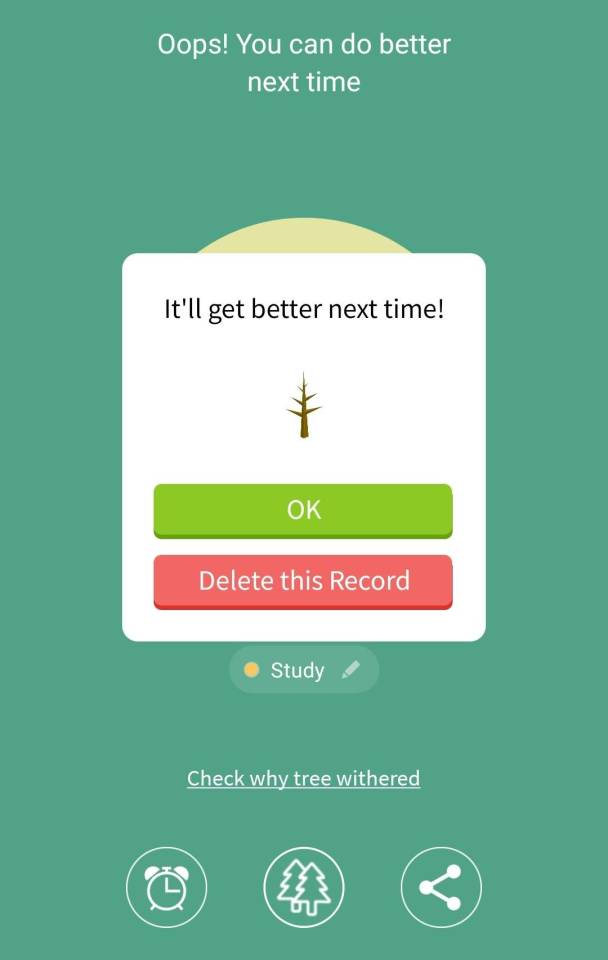
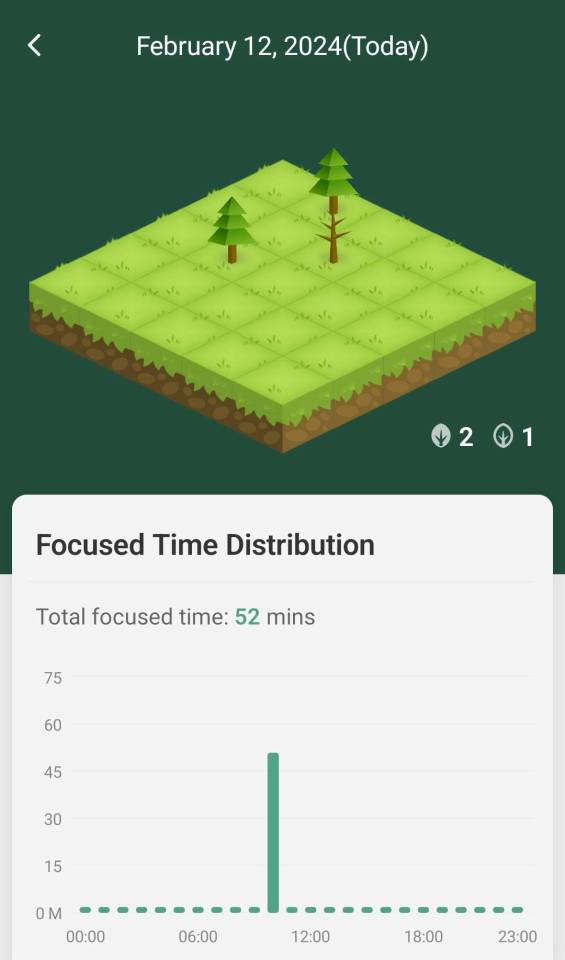
Overall rating: Certified, with stipulations. Here's the tl;dr
App includes a disincentive for failure (tree death), so if you're sensitive to even mildly feeling like you've fucked up, this might not be your bag
Low on novelty, so if you need a variety of goals to pursue quickly, this might not be your bag (other plant unlocks take a lot of time, forest grows one 25 minute increment at a time)
Achievements and events are a big plus, with several relatively easy achievements to keep you going.
No Dark Mode
supports a charity so that's pretty cool
Diamonds shop even after a 1 time purchase: go no further if you are susceptible to impulse purchases, I respect them keeping the lights on with optional bonus content, but it can be easy to chase the Purchase Dopamine and we need to say No Thank You
Red Flags: None, this app has been going steady for a few years and for seemingly pretty good reason. I didn't find any red flags with the charity it supports either. It's not on a subscription model, and nothing in it seems to be ridiculously priced.
Dopamine hits: Okay so the main drive for using this app is growing the big old garden of trees, collecting different trees, and seeing the physical space of that garden grow. With this said I have One Major Concern I'd like to get out of the way.
Are you the kind of person that's going to feel like shit if you let a plant die? Will you accidentally tab out, kill a tree, and be miserable out it? Do not use this app.
It DOES let you clear the dead trees out of your garden (see above) but personally I don't find disincentives like that as compelling as positive reinforcement. The app is encouraging about it (as you can see) but personally I'm wary of things where I can receive what feels like a punishment because I was only productive for five minutes and not the allotted ten I needed in order to keep the tree alive. the stopwatch mode reduces this, somewhat, but again, you need over 10 minutes. Make sure you allow texts or calls in allowed apps in settings so if something comes up you don't have to feel bad about killing a tree.
Features: Forest provides you one or two different tree types you can grow as you focus, and a nice little plot of land. I'll be honest, I don't think the free version gives you very much to work with, but the premium version gives you different kinds of trees you can grow, events, social connections, tracking, custom tagging system so you can track what you're spending your time off your phone doing, and best of all, achievements. Forest also comes with both a count-down and a stopwatch mode so that if you'd like to just study or work as long as you can you don't have to just do it in increments, which is nifty, and a change from some other pomodoro counters/timers. If using the app to just do poms/increments, there's a switch to keep the app on while you work.


Price: This app is a freemium (on android), but honestly, if phone restriction usage apps are useful for you, just buy the thing right out of the gate. It's 3.99 (also the price of the entire app on the apple store) and what you get for that price is like 99% of the functionality of the app imo. 3.99$ for a one-time unlock is ridiculously cheap for what you're getting. However. The other trees do take a hot minute to unlock. So if you need that cheap and easy serotonin and you have an intense need for novelty this might not be the move.
I will add a stipulation here: Make sure that phone restriction apps are actually what you Need if this is what you're using. if you're the kind of person who can respond to messages and still be productive, this may not be your bag. If you're on a computer and you're going to end up scrolling through tumblr on your laptop instead of your phone, this may not be your bag. Phone restriction apps are useful mainly if what you need to do is get off tech and go do something physical, like read a book or do chores. I do Not recommend this if what you're trying to do is write an essay on your laptop. It is just as easy to procrastinate on pc as it is on your phone. However, For What It Is, this app is extremely functional.
This app DOES have a diamond store and in app purchases to make extra cash but frankly I don't actually begrudge them this. With a one-time purchase that cheap and regular events that seem to allow you to unlock other plants, they seem to have a good content balance and hey, whatever they have to do to keep the app running. I just launched it again and it reminded me I have the pro version even through I bought that like eight years ago.
Polish + Customization: I'm grouping these together because I really have the same quibble for both, there isn't a darkmode on the settings screen, which is an annoyingly bright white compared to the rest of the app. News is Also bright white, so is the store, generally a lot of the things off the main page are bright white with no option to change them. I do not love that. But everything is easy to find and adjust, and though the load times can be a little slow (which is annoying) I generally can't complain too much.
Roadmap: News tab indicates that the app is still being updated and having new plants added, despite the developers seemingly have a couple other projects going- they've got a to-do list app I'm going to have to check out and one to prevent you using your phone while sleeping.
So there u go: Proceed with caution and respect for your specific needs, but it's top of the line in its category, imo. You just need to make sure that category is what you're looking for.
#adhd#app review#review request#forest#phone usage control#will update this review if I find out that charity is a scam but#it seems like they plant four new trees per user or something like that from their own notes and that's nifty#personally this app wasn't for me because I got sad about trees dying and also phone use restriction isn't my main issue#but i'm sure for someone somewhere this is just what they need#certified
14 notes
·
View notes
Text
Review: Prismatext
So I saw and ad for this lately, and it reminded me of why I hated its advertizing claims.
Prismatext teaches by weaving target language words into a text that is mostly a language you understand. For example if you know english and are learning japanese, the majority of the book would be english and you'd come across occasional japanese words.
The positive of this method: it does seem to help with some vocabulary learning, as it is a very good structure for "learning new words by guessing with surrounding context" since you understand ALL surrounding words except the unknown target language word. I would say for a total beginner or low beginner (under 500 words known) this method may be more appealing than other potential methods like flashcards or vocabulary lists. Although depending on your target language, i feel a graded reader in the target language made for your reading level would be a much faster way to learn beginner words. For example, with Mandarin Companion graded readers you can start reading them knowing only 150 characters, and keep using them to learn up to 450 characters. The Mandarin Companion graded readers would also give you ample practice time reviewing what you learned and practicing understanding it quicker. Where in comparison, the prismatext "text weaving" method you will not get constant review of target language words you know, won't build reading skills in the target language, and won't be exposed to any more new words than a Graded Reader. So I'd guess that while text weaving like prismatext may suit some people for learning 100-500 words, after that they'll likely be able to find target language Graded Readers and will find those probably more useful. And with some languages they can switch to graded readers before 500 words learned.
The down side of this method: to be frank, its extremely slow. Studying a word list (even just 20 words) then reading a graded reader text at your reading level or your reading level Plus the 20 new words? Is exactly what textbooks generally do and much faster learning of 20 words in a short amount of time. Reading graded readers with NO vocabulary lists to study, such as comprehensible input designed books (French by the Nature Method, Lingua Latina), allow you to learn 100 words in a very short amount of time all by just guessing words with surrounding context that is designed to be easy to understand and help you. Even regular graded readers, at your reading level (so if you know 300 chinese words and read a 200 unique word graded reader), will likely teach you 20-50 new words in a few hours AND give you tons of practice understanding all the words and grammar you already have studied. Making your understanding of thungs you know faster and easier, due to the practice. Frankly the biggest downside of weaving only the occasional target language word into a text is... its an extremely slow way to learn compared to other methods that use the same method of "learn something new'seaning by guessing using surrounding context."
The worst part of prismatext in particular: their books only have "hundreds" of target language words. You spend a few to several hours reading the prismatext book. You get exposed to (optimistically) 500 words. In the best case scenario, the book also reused and therefore reviewed the 500 words enough that you really learned them well. Most of your reading time was Not spent reading target language. Ideal best case scenario: you spent 2-15 hours on the prismatext book and then switch to graded readers. Because graded readers can keep teaching you MORE words up to 1000-3000 words, and often are offered at a reading level of 500 words (or even less in many languages). So prismatext... will be useful for one book. After that, its going to be way too slow to keep using it for another 599 words (assuming optimistically that prismatext offers as high a "hundreds" number of words they can). After one prismatext, most any other study method's going to be faster.
The first prismatext read is going to only really be ideal for: total beginners who know less than 500 words, readers who prefer learning by reading context (so they'll likely transition to graded readers afterward) but are still finding graded readers too frustrating at this total beginner stage, total beginners who absolutely loath alternate word study methods (flashcards, wordlists, no graded readers for their level or too difficult feeling, comprehensible input youtube videos bore/don't interest them, textbooks) and don't care if study time is a few times longer... text weaving is a Very Easy exposure to target language, so it is going to feel the least "hard." If a studier is a total beginner they might appreciate going slow at first so this may suit them at least for 1 prismatext/text weaving book. I personally get demotivated unless i see progress, so the low unique word count of target language words (only "hundreds") would frustrate me when after 20 reading hours i knew so little (whereas if i used a wordlist or graded readers, i could study same or more words in 20 hours but get way more review practice such as with graded readers). I think prismatext might work well with kids who it would be okay to take 3 times as long to learn the content an adult might learn, and kids for whom easiness is a HUGE factor on if they keep studying or not. For people who don't care if study time is longer if its easier, text weaving like prismatext would be a nice relaxing way to wade into the first few hundred words then move onto another tool.
My biggest gripe with prismatext: 1. They don't market like theyre only for total beginners. I'll tell you now, if you're B1 prismatext is unlikely to be useful at all despite the website's claim. Total beginners will see the most benefit for reading time on prismatext books. 2. They say vaguely their books teach hundreds of words, and back when it was designed i was following them and the total hundreds of words was like 200-300. Not nearly enough. Even an absolute beginner will probably want to learn 500 words from a resource! So they can know enough to start studying with more resources and do stuff in the language! Related to that: prismatext does not make it easy to find the target language word count. Why hide the word count? Why make it hard to find? Unique target language word count would indicate what language level a learner should read it at, how much potential benefit they'll get from it. Without a specific word count i can only guess how useful or not a book will be for a given learner. 3. There are apps like internet browser extensions that text weave target language words on website pages, that are free or low cost, that ultimately teach thousands of words instead of a few hundred. Those tools would be a better fit for upper beginner and intermediate learners, and for total beginners who want a guarantee they'll keep learning many more new words regularly even if theyre choosing text weaving rather than a faster exposure method like graded readers.
3 notes
·
View notes
Text
Turning Handwriting into Text, Part 1
I have what seems to be a never-ending quest. I love to write by hand. I do my best thinking when I do so. I’m at my most creative.
I create my characters, write the story of how they received their wound, describe their goals and motivations, go into detail about what’s holding them back from achieving their goals. From those notes, I create my plot — first the major plot points (instigating…

View On WordPress
2 notes
·
View notes
Text
I got a new drawing app and oh my goodness gracious me
It's like a piece of my soul was missing until today.
just to summarise...
App 1: The drawing app that came with the device
difficult to move the page around. couldn't rotate to suit my wrist positioning, which was uncomfortable and wated a lot of time.
limited to no colours. like, you couldn't adjust opacity, choose a specific colour, and the tools were: pencil, pen, highlighter, ruler, rubber.
constantly shutting down, took forever to load, rarely saved my doodles (and yes, they are no way as good as anyone's here and I do not consider myself an ✨artist✨ but I liked those nonetheless).
couldn't zoom in, so I had to just wing the finer details and pray to the stylus gods that my lines weren't wavy.
APP 2 (le flourish) Adobe Fresco
can ROTATE the screen to suit my preference, meaning no more questionable angles (praise the lord).
can CHOOSE any colour, edit opacity, even WATERFLOW for christs sake, and every possible art tool known to humankind.
Easy and straightforward to use, and is reliable when saving, as my device shut down and it saved regardless
can zoom in to the point where 1 pixel takes up the whole screen (not that i'd ever do that lmfao)
nevertheless, the old one served me well. Rest in Pieces.
7 notes
·
View notes
Text




Photography App Recommendation:
「EE35 Film」
Randomly stumbled across this app through a post written by another fellow internet friend. As someone that goes crazy for imitation camera apps, I decided to take a bet and purchase it for the price of $2.79 Canadian.
I have to say, out of a lot of the photo apps I’ve tried and downloaded before, this one really impressed me. Through its design to process to filter to end product, this app does a great job in imitating a true film camera with it’s advance to shutter to flash to developing. It great the user with having to load the film, and then a friendly guide on how the camera operates, closely similar to a real film camera.
The only thing I dislike about it is that it costed me 3 bucks. Although it is an impressive app, it doesn’t compare with app such as 「Filmroll」 or 「Nomo Cam」 But it’s on its way. I wouldn’t highly recommend due to its cost, but I think it was a half worthy purchase.
#photography#film photography#original photography#film imitation#film app#camera#camera app#film camera app#app recommendation#film photo#app review#filter#original
8 notes
·
View notes
Text
an ode to the storygraph
the storygraph really transformed how i read, and i cannot recommend it enough. great alternative to amazon etc etc but also! seeing what i enjoyed in graph form really helped me to articulate the kinds of books i wanted to read. it’s kept me out of reading slumps and given me language to describe books that will appeal to people outside of just using tropes or comparing books to other books.
for example, i enjoy books that are adventurous, emotional, dark, mysterious, and reflective. yes, i am a sad gay recovering 00’s emo kid.
it’s also great to see a breakdown of the genres i am reading, and being able to track them over time. LGBTQIA+ is my second most read genre in 2022, but before i came out and really sought out queer lit, i had almost no books in that genre. seeing how my access to genres that are important to my identity have grown is both meaningful and validating.
finally, the book descriptions and content warnings are just — perfect. I love seeing the genres and moods first, then being able to see community-submitted moods and content warnings. content warnings can be hidden for those reckless spoiler-free crowds, but i feel so much safer knowing what to expect when I go into a story. the fact that the community submitted star rating is the least prioritized item is the cherry on top of the book page design. book ratings can be so arbitrary out of context and so personal.
storygraph you beautiful app, ily




2 notes
·
View notes
Text
Possible accessible OSDDID App Review
Simply Plural !

Facts:
What type of app it is: An app for tracking what parts/alters are fronting
Compatibility: Seems to be available for apple and android products, as well as browser support
Size: 66.5 MB
Internet required: Yes
Does it share my data?: You’re able to share your information with friends. Most things are set to be private initially
Lockable: You can log off as needed
Light and dark mode are available in-app as well as syncing with your device’s settings. There’s also a more accessible font option, which I thought was a nice touch.
~
Personal thoughts:
Personal difficulty using(0 being the most easy, 10 being impossible): 9
How easy to add your parts: 2
How easy to switch between parts: 7-8?? It took me a long time to figure out how to even do this, but once you figure out how its maybe a 5
Personal avoidance level: 10, no parts wanted to use this app
Safe to say, I’m perplexed by this app. Let me show you some screenshots

We start with this clusterfuck of options. As someone who’s dissociating and dyslexic all these different directions that hold the exact same weight as eachother are really confusing! A young or badly confused part might think User Report is the same thing as making a note of who’s out right now
Maybe this is helpful to someone, but to me, it looked like way too much even on a present day

This is the ‘Members’ list. Where all the parts are listed. There are a lot of symbols here that aren’t listed in any of the help sections that I’ve had to clumsily figure out by trial and error. Like apparently the arrows next to the names are.. Making a note of who’s here in the moment? I had no idea until just now.
Also they’re sorted alphabetically. Never in the history of Ever have I sorted my parts this way?? Sorry, this is the stuff I’m really specific about.
Evidently the bottom buttons are how to view who’s fronting at the moment. I can’t figure out what ‘custom front’ is for

Here’s what a part looks like when you open them up from the list. You have a lottttt of info you can go through and add using the icons at the top. I like that it has this many options for people who are probably a lot more serious for the use of the app.
When I first used it some years ago, I had no idea the Visibility was an option, so you might want to make sure it’s set to what you need it to be to feel secure (Private, shown to trusted friends, or shown to all friends)

Here’s the side bar, with lots and lots of options again, but at least these are a little more sorted and I would’ve preferred this for the main page.
Now, let’s look at Add Front Entry...

Okay, so there’s a detailed front entry and a quick front entry option. The detailed front entry looks like this:
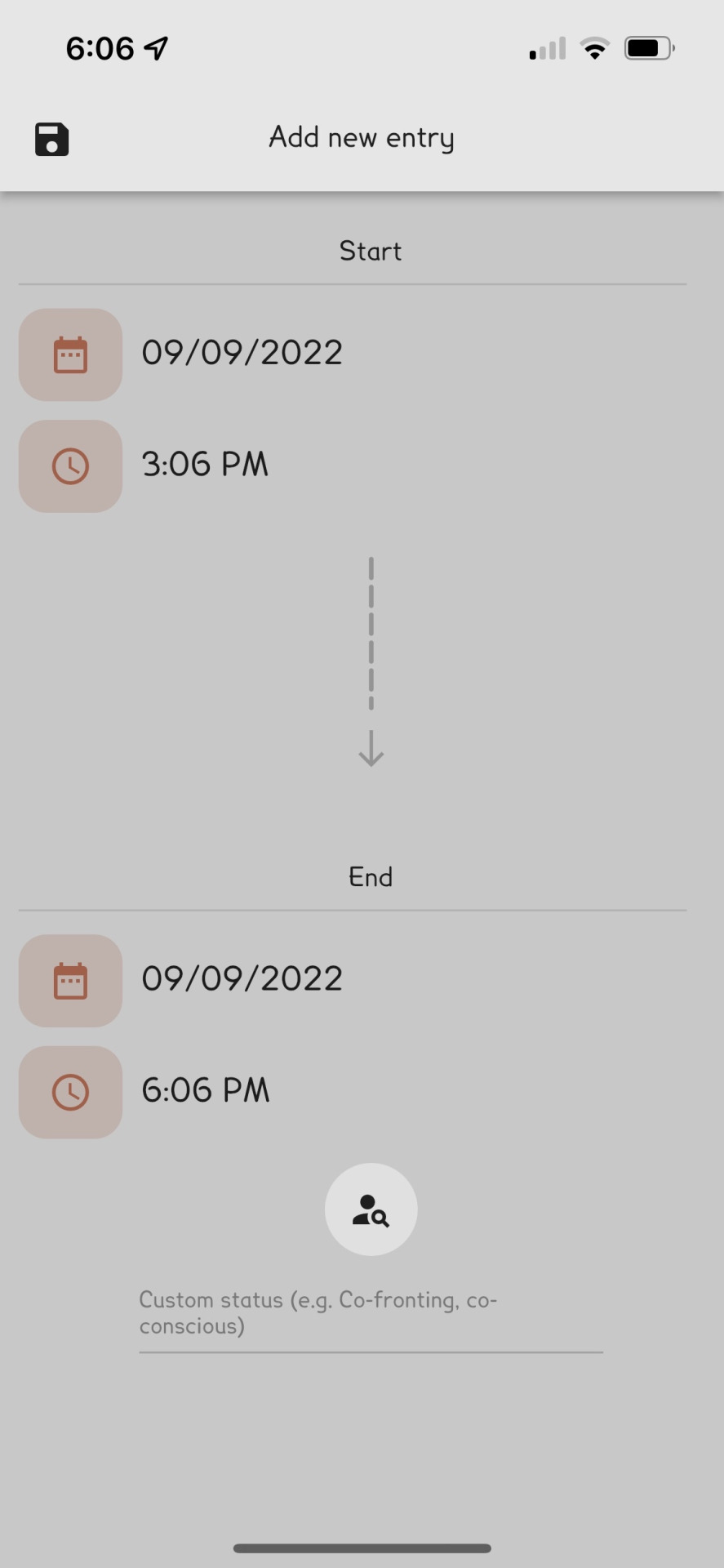
....
My dear OSDDID friends, I ask you, Do you know how long the part previous to yourself started fronting, from the date, the hour, the minute?? and when they stopped???????? Not even you, the previous parts who were here.

I think the quick entry would’ve been better if you could add the hours options yourself, because most everyone I know with a dissociative disorder has a very different rate of switching, and 2 hours is not enough for the people who might switch once in days or weeks. (I personally shift from one group of parts to another every few days to a week)
At this point if you’re thinking that “She just doesn’t understand, I’ve been using this app and it just takes a learning curve to use..”, I invite you to realize that this app has no margin for error, no lenience for our I Don’t Know Myself Disorder, no room for considering dissociation and it’s varying forms and general blurriness.
I wondered for a moment why it was like this...
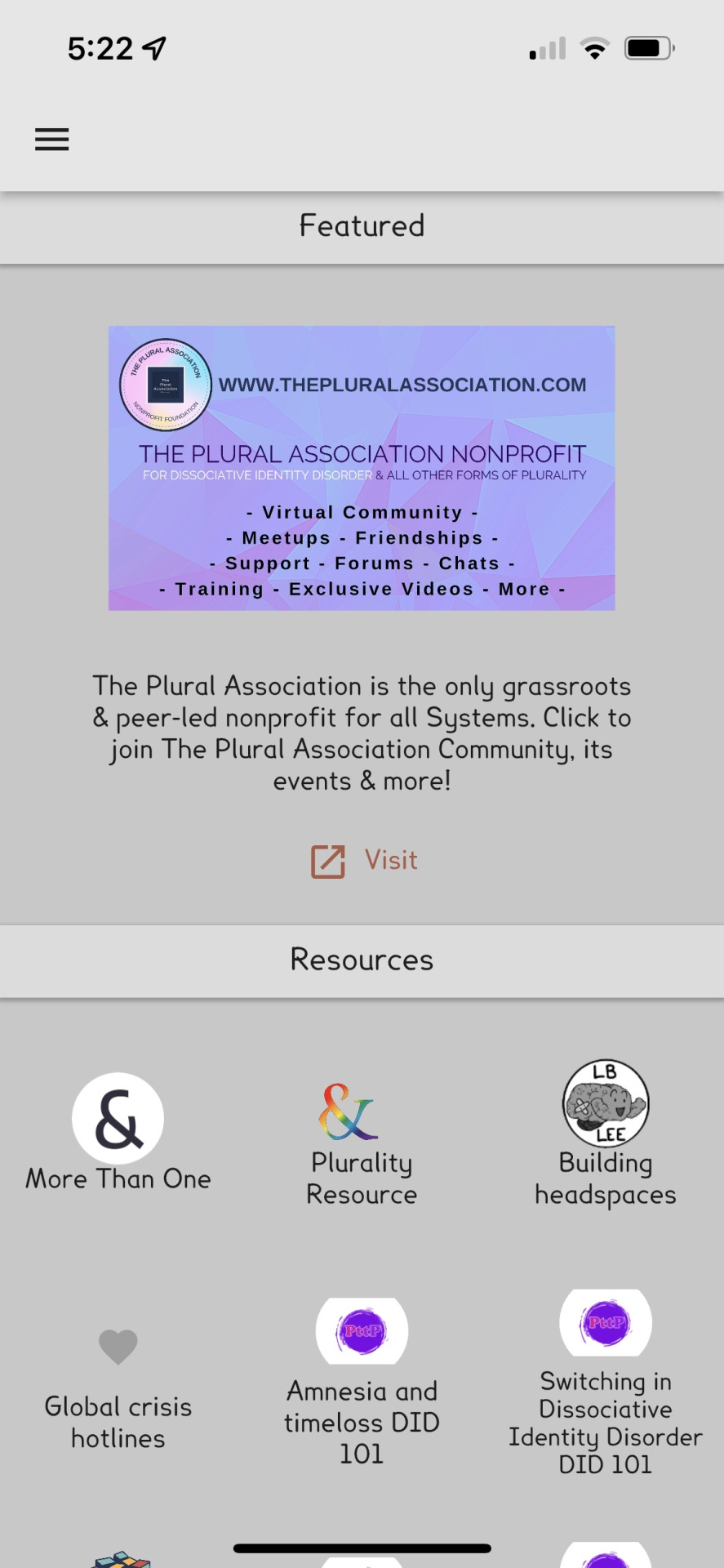
Ah-ha.
The Plural Association is organization that hopes to eliminate the difference between OSDDID and non-disordered plurality, effectively de-medicalizing a Dissociative Disorder.
I read some of these links and quite a few of them focused on the ‘beautiful mind of having plurality’ rather than the dark reality of where a dissociative disorder comes from, being a trauma disorder. Downplaying DID as ‘Not Getting Along With Your Headmates’ disorder. There was just enough reasonable and flowery language for them to sprinkle blatant misinformation throughout, tricking you into believing things that may be harmful if you actually have a Disorder that needs treatment.
I have no doubt that people with non-disordered plurality are experiencing something. I can’t claim to know enough about someone’s mind to say otherwise, of course. I think saying Endogenics don’t exist shuts down people who might actually need help.
However, the mixture of OSDDID and Endogenics like this is very very harmful when it comes to creating ‘accessibility’ like this. It takes away from the actual point of what would be helpful for someone with a DD, like communication between parts, the slow breakdown of dissociative barriers, and for many, the lesser separation between parts and goals towards coming together.
The Plural Association wants you to be separate, but also know all parts, which can be incredibly dangerous to venture into yourself if you have a lot of trauma(and therefore parts) you don’t know. Integration, Fusion, and taking it slowly and at the pace recommended by a professional, are really wonderful and personal parts of healing and shouldn’t be snubbed out by the pressure to be As Plural As Possible. Exactly like this app does
Final thoughts:
This app is needlessly complicated. I mean, maybe it can be really helpful if you go through and learn everything about it. I’ve only been picking at it for a week and barely scratched the surface. I feel like it must be like an art program, it takes you a lot of hard work and practice to settle into using it.
The premise is not at all for me. Not in all my years of knowing and figuring out my DID have I ever found it useful to *just* have a record of who switched when. Sure, it can be enlightening. But I’d find a lot more use in a text app where my Personas can make note of what’s going on in the moment, how they’re feeling, why they’re there.
Simply Plural is not at ALL simple or accessible to the common dissociated user.(me) Many times I peeked at it, I got confused easily and lost. It feels like a winding house where one room leads to the next and the next without hallways.
It’s a lot especially for people who have less distinct parts too. or many of them! they’d all be placed in the same alphabetical order without any distinction between distinct and nondistinctive parts, or subsystems.
I’m extremely uncomfortable that you could technically find people on here, and find their information if they didn’t have the right privacy settings on. I didn’t feel completely safe putting all my parts on here, capping it at the main 16. Even more so, there’s the ability to give someone a ‘token’, which is customizable access to your information, including being able to write and add things, as well as delete them. I could easily see an abuser use this for the worst. What in the world?!?!?
I try to keep my reviews light and positive because I believe there’s merit in any DID media to various ranges of accessibility for people. But this one I just cannot recommend. I hope you understand my points as to why
If this app works for you, dissociation and all, then I’m really glad for you! If you’re endogenic and don’t have dissociative issues, maybe it’s more suited to whatever it is you...do with your parts? ? (I don’t know enough, sorry)
Would I recommend this app to someone with OSDDID? Nope.
#dissociative identity disorder#otherwise specified dissociative disorder#actuallydid#simply plural#did apps#DID in media#dissociative identity disorder media#app review#app recommendation#long post#bunnidid reviews
143 notes
·
View notes
Text
YuSpeak · app review
(。•̀ᴗ-)✧ review

Are you on a quest to master the Japanese language? If so, you've likely explored various language learning apps to find the one that suits your needs. YuSpeak is one such app that offers a promising platform for learning Japanese. In this review, we'll take a closer look at the pros and cons of YuSpeak to help you make an informed decision.
Pros:
Strong Foundation for Beginners: YuSpeak shines when it comes to providing beginners with a solid foundation in Japanese. You'll learn kana and in general the app has a great way to sum up grammar points, making it accessible to those starting from scratch.
Effective Review Methods: Learning a new language requires consistent practice and review. YuSpeak offers practical methods for reviewing grammar and vocabulary, helping learners reinforce what they've learned. (I personally found them handy with flashcards and not only the same exercises)
Cons:
Limited Free Content: Perhaps the most significant drawback of YuSpeak is its restriction on free content. While it offers a great starting point for beginners, the free version provides access to only 11 lessons out of a total of 30 or more, depending on the level (beginner I, beginner II, etc). Once you've completed these free beginner lessons, you'll hit a paywall if you wish to continue your learning journey.
Not Ideal for Intermediate Learners: If you already have a basic understanding of Japanese, you might find YuSpeak less useful (at least the free version). The app's content is geared primarily towards beginners, which means you may not learn much new material if you already have a foundation in the language.
Premium Requirement for Full Access: To unlock the full range of content and progress to more advanced lessons, you'll need to opt for the premium version of YuSpeak. While this is common among language learning apps, it can be a drawback for those on a tight budget.
Final Thoughts ✮✮✬✩✩
YuSpeak has its strengths, particularly for beginners seeking a strong introduction to Japanese alphabets, grammar and vocabulary. Its effective review methods can also be beneficial. However, the limitations on free content and the lack of material for intermediate learners are notable drawbacks. Whether YuSpeak is the right choice for you will depend on your current language proficiency, commitment to learning Japanese, and budget. It can be a valuable tool in your language learning journey, but be aware of its limitations before diving in. I found it very limiting due to the premium paywall, but that's because I think I might spend my time and money in other resources that might be more efficient for me!
Let me know what do you think about the app if you did try it and let's share experience and resources!
またね~@inkichan
꒰ა ˚₊ ✧・┈・╴﹕꒰ ᐢ。- ༝ -。ᐢ ꒱﹕╴・┈・𐑺 ‧₊˚໒꒱
#japanese#nihongo#studyblr#learn Japanese#learning Japanese#japanese langblr#langblog#japanese studyblr#日本語#review#YuSpeak#app#language app#app review#YuSpeak app#japanese learning app
12 notes
·
View notes
Text
Buy app Reviews and Rating
Discover the key to unlocking your app's potential with Social Reputation Pro. Safely buy app reviews and ratings to boost your visibility and trust among users in India. Elevate your app's reputation and watch your download numbers soar. Join us on a journey to success.
0 notes
Text
Roubit: Gamified Habit Builder
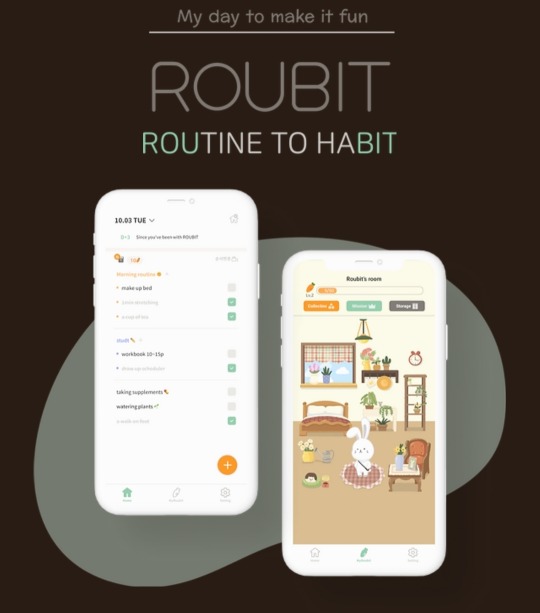
Rating: BULLSHIT
Monthly subscription fee hidden behind a free install with extensive in-app purchases
Unimaginably bad data privacy practices. This is a data miner.
Heavy AI integration— AI responses to your journal entries so you can develop a parasocial relationship with this bunny trying to scam you. Great! 0/10
10 notes
·
View notes
Text
i’m going to blog a bit about the Smart Books app later today i think. it’s a nice free app and i highly recommend it. the biggest feature it has that makes it unique among all the other Reader apps that also work well? Smart Books makes parallel text translations of every sentence in a file you open in the app.
Pleco can give click-translations for words, which are excellent, and Pleco can also machine translate an entire passage (using google translate). But Pleco cannot give sentence by sentence machine translations. So it’s hard to compare the machine translated LONG passage to the chinese passage in Pleco, therefore Pleco is mainly used for individual word translation. The web browsers can all do click translation (Chrome, Mozilla, Edge) and they can do parallel translation of highlighted text, but it requires some time consuming highlighting then clicking ‘translated with google translate/deepL/etc” then that app is opened then clicking ‘translate.’ Yes, it only takes 1-2 minutes, but that’s longer than the 1 second click it takes in Smart Books.
In Smart Books app, you open a book, then it separates the book into shorter lines and lets you play TTS audio for each line and click a button on the right of each line to translate it and display a parallel text translation right below the line. The result is: you can replay a line of audio over and over if you need to re-listen to one sentence without having to pause, go back and re-highlight the beginning again etc. You can display a parallel translation when you need it, and keep it up to look at or hide it again, whenever. With just a quick click. (And if you like Listening Reading Method, you can conveniently have audio, target language text and translation text, for each individual line so you can repeat as much as desired). The parallel translation is also nice because sometimes looking up individual words still doesn’t clarify the grammar going on in the sentence and it’s overall meaning. Oh also, you CAN also look up individual words in Smart Books by just clicking the word. You can also save words, similar to in Pleco or Anki.
The parallel translation quality: fairly good. I think it’s a little better than Google Translate, about as good as DeepL. So far I have seen mistakes of switching pronouns between he/she/it if the pronoun isn’t specified or was only specified in the previous sentence (and confusing ta for he/she/it in chinese translations is quite common with mtl), some mistakes of who is performing a verb and who a verb is acting on if the sentence does not specify explicitly (so the mtl just makes an assumption, go by what the sentence before it meant to clarify who did the verb in the next sentence if no noun was specified in the sentence with the verb). It’s done very well with chinese names and places, which I’ve been surprised by because Google Translate’s biggest issue translating chinese is trying to translate names as literal objects adjectives etc. The parallel translations are still machine translations and of course nowhere near as good as translations made by people, but of the machine translations I’ve seen, Smart Book’s mtl seems as good as DeepL and possibly even a little bit better. I suspect because DeepL will use context from prior sentences to translate future sentences in a passage, meaning if there’s an error at some step then the entire passage can get the error. Whereas Smart Books translates lines individually, so when I see a translation error it only tends to be in a single line and the rest of the lines are translated fine. (And usually the error is, as I said: a pronoun is not used in the chinese line so the translation puts the wrong pronoun when translating to english, or the verb used in the chinese line has no explicitly written subject/object to the translation just makes an assumption in the english to assign something as subject/object).
5 notes
·
View notes
Text
Want to Create New Habits? There's an App for That!
Many people know about James Clear’s book Atomic Habits. It’s a book about how to get rid of bad habits and create great habits that improve your life. It has helped millions get rid of bad habits and establish new ones.
I love how habits and routines created from habits have improved my life. With better habits, I can get more done in a day and get closer to becoming the person I always…

View On WordPress
#app review#Atomic Habits#Atoms#changing bad habits#creating a healthier lifestyle#creating good habits#James Clear#there&039;s an app for that
0 notes
Text
Facebook Messenger App - January 2019 Update Looks Horrid! (App Reviews) (Reviews)
Review By: Warren Woodhouse
I load up Messenger, same as usual, now everything looks like how Microsoft does makes things look, if I wanted this I would still be using Skype rather than Messenger!! It looks terrible and it’s hard to navigate as well, making it an incredibly very unfriendly experience for a disabled person such as myself. Looks horrible now than in the previous versions before. So I’ve decided to give it a rating of 2 instead of the usual 5 rating because of my current experience and would love an update soon otherwise I’m going to use a different messaging service.
Sometimes messages don’t come through in the previous update. Chat Extensions need the ability to add directly to Home Screen but this doesn’t happen in all Chat Extensions even in the current version.
0 notes